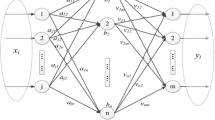Abstract
In this paper, we introduce a new learning method for composite function wavelet neural networks (CFWNN) by combining the differential evolution (DE) algorithm with extreme learning machine (ELM), in short, as CWN-E-ELM. The recently proposed CFWNN trained with ELM (CFWNN-ELM) has several promising features. But the CFWNN-ELM may have some redundant nodes due to the number of hidden nodes assigned a priori and the input weight matrix and the hidden node parameter vector randomly generated once and never changed during the learning phase. The introduction of DE into CFWNN-ELM is to search for the optimal network parameters and to reduce the number of hidden nodes used in the network. Simulations on several artificial function approximations, real-world data regressions and a chaotic signal prediction problem show some advantages of the proposed CWN-E-ELM. Compared with CFWNN-ELM, CWN-E-ELM has a much more compact network size and Compared with several relevant methods, CWN-E-ELM is able to achieve a better generalization performance.
Similar content being viewed by others
References
Zhang QH, Benveniste A (1992) Wavelet networks. IEEE Trans Neural Netw 3(6): 889–898
Szu H, Telfer B, Kadambe S (1992) Neural network adaptive wavelets for signal representation and classification. Opt Eng 31(9): 1907–1916
Szu H, Telfer B, Garcia J (1996) Wavelet transforms and neural networks for compression and recognition. Neural Netw 9(4): 659–708
Zhang J, Walter GG, Miao YB, Lee WNW (1995) Wavelet neural networks for function learning. IEEE Trans Signal Process 43(6): 1485–1497
Zhang QH (1997) Using wavelet network in nonparametric estimation. IEEE Trans Neural Netw 8(2): 227–236
Liu Q, Yu X, Feng Q (2003) Fault diagnosis using wavelet neural networks. Neural Process Lett 18: 115–123
Subasi A, Yilmaz M, Ozcalik HR (2006) Classification of EMG signals using wavelet neural network. J Neurosci Methods 156(1-2): 360–367
Xu JX, Tan Y (2007) Nonlinear adaptive wavelet control using constructive wavelet networks. IEEE Trans Neural Networks 18(1): 115–127
Pan H, Xia LZ (2008) Efficient object recognition using boundary representation and wavelet neural network. IEEE Trans Neural Networks 19(12): 2132–2149
Yoo SJ, Park JB, Choi YH (2008) Adaptive output feedback control of flexible-joint robots using neural networks: dynamic surface design approach. IEEE Trans Neural Networks 19(10): 1712–1726
Jin N, Liu DR (2008) Wavelet basis function neural network for sequential learning. IEEE Trans Neural Networks 19(3): 523–528
Oussar Y, Dreyfus G (2000) Initialization by selection for wavelet network training. Neurocomputing 34(1-4): 131–143
Lin C-J (2006) Wavelet neural networks with a hybrid learning approach. J Inf Sci Eng 22(6): 1367–1387
Haykin S (2001) Neural networks: a comprehensive foundation, 2nd edn. Pearson Education Press, Asia
Huang G-B, Zhu Q-Y, Siew C-K (2006) Extreme learning machine: theory and applications. Neurocomputing 70(1-3): 489–501
Serre D (2002) Matrices: theory and applications. Springer, New York
Cao JW, Lin ZP, Huang G-B (2010) Composite function wavelet neural networks with extreme learning machine. Neurocomputing 73(7–9): 1405–1416
Storn R, Price K (2004) Differential evolution—a simple and efficient heuristic for global optimization over continuous spaces. J Glob Optim 11(4): 341–359
Zhu Q-Y, Qin A-K, Suganthan P-N, Huang G-B (2005) Evolutionary extreme learning machine. Pattern Recognit 38(10): 1759–1763
Subudhi B, Jena D (2008) Differential evolution and Levenberg Marquardt trained neural network scheme for nonlinear system identification. Neural Process Lett 27: 285–296
Levenberg K (1944) A method for the solution of certain non-linear problems in least squares. Q Appl Math 2: 164–168
Huang G-B, Zhu Q-Y, Mao K-Z, Siew C-K, Saratchandran P, Sundararajan N (2008) Can threshold networks be trained directly?. IEEE Trans Circuits Syst II 53(3): 187–191
Zhou B, Shi AG, Cai F, Zhang YS (2004) Wavelet neural networks for nonlinear time series analysis. Lecture notes in Computer Science, vol 3174. Springer, Berlin, pp 430–435
Bartlett PL (2008) The sample complexity of pattern classification with neural networks: the size of the weights is more important than the size of the network. IEEE Trans Inf Theory 44(2): 525–536
Hsu C-W, Lin C-J (2002) A comparison of methods for multiclass support vector machines. IEEE Trans Neural Netw 13(2): 415–425
Author information
Authors and Affiliations
Corresponding author
Rights and permissions
About this article
Cite this article
Cao, J., Lin, Z. & Huang, GB. Composite Function Wavelet Neural Networks with Differential Evolution and Extreme Learning Machine. Neural Process Lett 33, 251–265 (2011). https://doi.org/10.1007/s11063-011-9176-y
Published:
Issue Date:
DOI: https://doi.org/10.1007/s11063-011-9176-y




